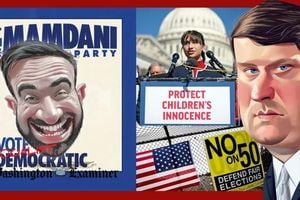As the United States government shutdown stretches into its second week, the ripple effects are being felt far beyond the halls of Congress. From grounded flights in Los Angeles to fiery exchanges on social media and cable news, the shutdown has become a flashpoint for deeper political and social divisions. At the heart of it all: partisan clashes over funding, public safety, and immigration policy, with California’s Governor Gavin Newsom and President Donald Trump trading especially sharp barbs.
On October 7, 2025, the Hollywood Burbank Airport, a key hub in the Los Angeles area, found itself in an unprecedented situation. For six hours, from 4:15 pm to 10:00 pm, the airport’s control tower was left without any air traffic controllers due to the ongoing government shutdown, as reported by Economic Times. The Federal Aviation Authority (FAA) issued a blunt advisory: “BUR TOWER ATC ZERO. RATE REDUCED DUE TO STAFFING.” Departures to Burbank were delayed by about two and a half hours, with the FAA confirming that staffing shortages were directly responsible.
In the absence of on-site controllers, a team in San Diego was tasked with handling air traffic remotely, communicating with pilots arriving and departing from Burbank. Despite the disruption, airport operations continued, though passengers were warned to check with airlines for updates on delays or cancellations. “We are advising passengers to check with their airline -- before arriving at the airport -- for updates on possible delays or cancellations,” a spokesperson told AFP.
Governor Gavin Newsom did not mince words in his response. Taking to X (formerly Twitter), he wrote, “Thanks @realDonaldTrump! Burbank Airport has ZERO air traffic controllers from 4:15pm to 10pm today because of YOUR government shutdown.” Newsom’s criticism underscored the frustration of many Californians, who saw the shutdown’s impact not just in delayed travel but in the broader uncertainty facing essential federal workers—including air traffic controllers—who are now expected to work without pay.
The government shutdown itself is rooted in a bitter standoff between President Trump’s Republican Party and congressional Democrats. At issue are funding extensions and the fate of health care subsidies, including those tied to “Obamacare.” Democrats have refused to back the Republicans’ preferred funding bill unless it includes an extension of expiring health care subsidies and reverses certain cuts to health programs. According to the nonpartisan Congressional Budget Office, the bill signed into law on July 4 would strip 11 million Americans of health care coverage, mainly through cuts to Medicaid for low-income families. Democrats warn that, without action, four million more could lose coverage next year and 24 million Americans could see their premiums double.
Republicans, on the other hand, argue that the health care subsidies are unrelated to keeping the government open and can be debated separately. The impasse has left most federal workers on enforced leave and without pay, though those deemed essential—like air traffic controllers—must continue their duties regardless of compensation.
Meanwhile, the shutdown’s consequences extend well beyond transportation. In a press briefing on October 6, Karoline Leavitt, a prominent Trump administration spokesperson, lashed out at both Democrats and a federal judge who had temporarily barred the deployment of National Guard units to Oregon. The judge, Karin Immergut—herself a Trump appointee—ruled that there was insufficient evidence to justify the deployment amid ongoing protests. Leavitt called the ruling “untethered in reality,” and described the situation at an Immigration and Customs Enforcement (ICE) facility in Portland as a “siege from anarchists” inciting violence. She vowed to appeal the judge’s decision, while also criticizing Democratic leaders like Governor Newsom for opposing federal intervention in urban safety.
Leavitt didn’t stop there. She claimed a proposed Democratic funding bill would cause Medicaid to cover emergency care for undocumented immigrants at a higher cost than for American citizens. This assertion, however, has been challenged as misleading, since federal law requires emergency Medicaid to provide care regardless of immigration status. Still, Leavitt insisted that layoffs resulting from the shutdown were “an unfortunate consequence” of Democrats’ refusal to support funding extensions, placing the blame squarely on the opposition.
The debate over immigration and law enforcement has also spilled into state politics. In September 2025, Governor Newsom signed a bill prohibiting facial coverings for law enforcement officers in California, a move aimed at countering ICE agents’ use of masks to conceal their identities. This legislation came amid reports that ICE officers had begun wearing excessive facial coverings after being doxxed by activists protesting Trump’s mass deportation policies. Newsom’s stance drew sharp criticism from Kristi Noem, the Secretary of Homeland Security and head of ICE, who appeared on Fox News to denounce the governor’s actions. “We have always known that words matter, but there have been real consequences that we have realized happen to incredible people,” Noem said, describing the impact on her family after a controversial tweet from Newsom’s press office.
The war of words quickly escalated on social media, with users pointing out similar rhetoric from President Trump himself. Screenshots of Trump’s 2020 tweet about Bernie Sanders—“Going to be a BAD day for Crazy Bernie!”—and a 2016 tweet about Hillary Clinton resurfaced, highlighting what many saw as hypocrisy in the outrage directed at Newsom. Trump’s own history with social media, including frequent attacks on political rivals and criticism of President Obama for playing golf, has only added fuel to the fire. Notably, Trump reportedly played golf 62 times between January and July 2025 during his second term.
Back in Chicago, Mayor Brandon Johnson has issued an executive order establishing “ICE-free zones” and supports a lawsuit against the deployment of National Guard troops, emphasizing local governance and constitutional rights. These moves, along with similar actions in California and Illinois, reflect a growing trend of state and municipal leaders pushing back against federal immigration enforcement and military intervention.
Amidst these domestic battles, the Trump administration has pointed to international achievements, with Leavitt describing ceasefire negotiations in Egypt as “an incredible achievement” and noting President Trump’s involvement in talks to release hostages and Israeli prisoners. The White House, for its part, is preparing for a series of high-stakes meetings, including one with Canadian Prime Minister Mark Carney, as it seeks to navigate the turbulence at home and abroad.
The government shutdown has become a microcosm of the nation’s broader political rifts, with each side blaming the other for the fallout. Whether it’s flight delays in Los Angeles, clashes over immigration policy, or dueling narratives on social media, the standoff shows no sign of abating—leaving millions of Americans caught in the crossfire and wondering when, or if, their leaders will find common ground.




